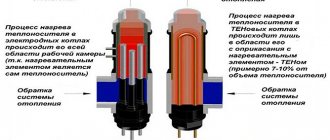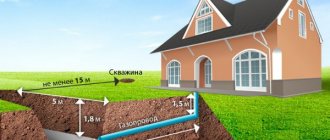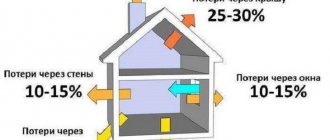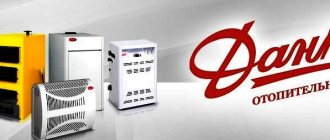Gas is still the cheapest fuel, so if you have a gas main, you should choose a gas boiler without hesitation.
According to surveys and practice, the top three most important selection criteria for most buyers include gas consumption. Despite the fact that it is indicated in the characteristics of almost every modern boiler, this does not allow you to quickly imagine the approximate cost of gas consumed per day, month or for the entire heating season. To make heating budget planning easier, it is enough to once understand the principles of calculating gas consumption by boilers.
We calculate how much gas a gas boiler consumes per hour, day and month
When designing individual heating systems for private houses, 2 main indicators are used: the total area of the house and the power of the heating equipment. With simple average calculations, it is generally accepted that for heating every 10 m2 of area, 1 kW of thermal power + 15-20% of the power reserve is sufficient.
How to calculate the required boiler power Individual calculation, formula and correction factors
However, for planning expenses it is more convenient to measure the work of gas boilers directly per cubic meter. m/hour (cubic meters) – if natural gas from the pipeline is used; or in kg/hour (kilograms) - if liquefied gas is used (which is much more expensive).
It is known that the calorific value of natural gas is 9.3-10 kW per m3, which means that for 1 kW of thermal power of a gas boiler, about 0.1-0.108 m3 of natural gas is needed. At the time of writing, the cost of 1 m3 of main gas in the Moscow region is 5.6 rubles/m3 or 0.52-0.56 rubles for each kW of boiler thermal power.
But this method can be used if the boiler’s passport data is unknown, because the characteristics of almost any boiler indicate the gas consumption during its continuous operation at maximum power.
For example, the well-known floor-standing single-circuit gas boiler Protherm Volk 16 KSO (power 16 kW), operating on natural gas, consumes 1.9 m3/hour.
- Per day – 24 (hours) * 1.9 (m3/hour) = 45.6 m3. In value terms – 45.5 (m3) * 5.6 (tariff for Moscow region, rub.) = 254.8 rub/day.
- Per month – 30 (days) * 45.6 (daily consumption, m3) = 1,368 m3. In value terms – 1,368 (cubic meters) * 5.6 (tariff, rub.) = 7,660.8 rubles/month.
- For the heating season (suppose from October 15 to March 31) - 136 (days) * 45.6 (m3) = 6,201.6 cubic meters. In value terms – 6,201.6 * 5.6 = 34,728.9 rubles/season.
However, these are only approximate theoretical calculations, since in practice the boiler does not operate 24/7 at full capacity: in this case, the wear of its elements accelerates many times over. A gas boiler correctly selected in terms of power (taking into account the area, heat loss of the house and a small power reserve of 10-20%) consumes only 50-70% of the values calculated above for the maximum possible operating mode of the boiler.
That is, in practice, depending on the conditions and heating mode, the same Protherm Wolf 16 KSO consumes 700-950 cubic meters of gas per month, which is about 3,920-5,320 rubles/month. It is impossible to accurately determine gas consumption by calculation!
To obtain accurate values, metering devices (gas meters) are used, because gas consumption in gas heating boilers depends on the correctly selected power of the heating equipment and model technology, the owner’s preferred temperature, the arrangement of the heating system, the average temperature in the region during the heating season and many other factors , individual for each private home.
Consumption table for well-known boiler models, according to their passport data
| Model | power, kWt | Max natural gas consumption, cubic meters m/hour |
| Lemax Premium-10 | 10 | 0,6 |
| ATON Atmo 10ЕВМ | 10 | 1,2 |
| Baxi SLIM 1.150i 3E | 15 | 1,74 |
| Protherm Bear 20 PLO | 17 | 2 |
| De Dietrich DTG X 23 N | 23 | 3,15 |
| Bosch Gaz 2500 F 30 | 26 | 2,85 |
| Viessmann Vitogas 100-F 29 | 29 | 3,39 |
| Navien GST 35KN | 35 | 4 |
| Vaillant ecoVIT VKK INT 366/4 | 34 | 3,7 |
| Buderus Logano G234-60 | 60 | 6,57 |
Calculator for quick calculations
Let us remind you that the calculator uses the same principles as in the example above; real flow data depend on the model and operating conditions of the heating equipment and can only be 50-80% of the data calculated under the condition that the boiler operates continuously and at full capacity .
Examples of converting liters to cubes
And now, armed with all the necessary knowledge, we can proceed directly to the calculations.
| Problem #1: How many liters are in 0.5 cubes? Solution: Using the above formula we get: 0.5 * 1000 = 500 liters. Answer: 0.5 cubes contain 500 liters. | Problem #6: How many liters are in 300 cubic meters? Solution: 300 * 1000 = 300,000 liters Answer: There are 300 thousand liters in 300 cubic meters. |
| Problem #2: How many liters are there in 1 cubic meter? (the simplest) Solution: 1 * 1,000 = 1,000 liters. Answer: 1 cube contains 1,000 liters. | Problem #7: 5 cubes - how many liters? Solution: 5 * 1000 = 5,000 liters Answer: 5 cubic meters is 5 thousand liters. |
| Problem #3: 2 cubes – how many liters? Solution: 2 * 1,000 = 2,000 liters. Answer: 2 cubes contain 2,000 liters. | Problem #8: 6 cubic meters is how many liters? Solution: 6 * 1000 = 6,000 liters. Answer: 6 cubes contain 6 thousand liters. |
| Problem #4: How many liters are in 10 cubes? Solution: 10 * 1000 = 10,000 liters Answer: 10 cubes contain 10 thousand liters. | Problem #9: How many liters are 4 cubes? Solution: 4 * 1000 = 4,000 liters Answer: 4 cubes contain 4 thousand liters. |
| Problem #5: 20 cubic meters is how many liters? Solution: 20 * 1000 = 20,000 liters Answer: 20 cubes contain 20 thousand liters. | Problem #10: How many liters are 500 cubic meters? Solution: 500 * 1000 = 500,000 liters Answer: There are 500 thousand liters in 500 cubic meters. |
Additional theoretical methods for calculating natural gas consumption
Based on heat loss at home
A visual representation of heat loss in a private home.
The exact heat loss of a house is calculated based on the area + adjustments related to the glazing area, the degree of insulation of the house, climate zone and temperature in the coldest ten-day period of the heating season. To put it simply, it is generally accepted that for every 10 m2 of an average house with 2-brick masonry and a ceiling height of up to 2.7 m, there is 1-1.2 kW/hour of heat loss. Accordingly, to maintain a comfortable temperature, it is necessary to establish a balance between the heat received from the heating system and heat loss.
Let's calculate using the example of an average house with an area of 100 m2, located in the Moscow region, which does not involve adjustments related to the climate zone. The heat loss of such a house will be about 11 kW/hour, the same amount will be produced by a gas boiler. Let us remember that the specific heat capacity of natural gas combustion is 9.3 kW. However, most gas boilers are 90% efficient, so adjustments must be made accordingly for efficiency.
Total gas consumption = 11 (kW/hour) / (9.3 (kW) * 0.9 (90% efficiency)) = 1.31 m3/hour, which is equal to 31.44 cubic meters per day. According to the tariff at the time of writing for the Moscow region, this is 176.1 rubles/day.
But, like other methods, calculation based on heat loss shows an approximate picture with deviations of 10-30% in each direction. In the warmest month of the season, consumption may be minimal, while in the coldest ten days, due to large heat losses, the boiler will operate at maximum capacity with the burners constantly running.
Consumption of a certain power by the boiler
Some calculate gas consumption based on the boiler power; this is appropriate if, for example, the boiler unit is quite old and the nominal consumption is unknown. Let's say you have a 10 kW boiler, for calculations you will also need efficiency, which is probably also unknown, but in practice the efficiency of old Soviet and post-Soviet gas boilers barely reached 70%.
We calculate the boiler consumption according to the principle already clear from the previous examples: 10 kW / (9.3 kW * 0.7 (estimated efficiency 70%)) = 1.54 cubic meters. m/hour or 36.96 cubic meters. m/day with continuous operation of the main burners. Gas consumption by the boiler is 24 kW = 24 / (9.3 * 0.7) = 3.69 cubic meters per hour.
Gas heating boilers: the most detailed selection instructions. Checklist for selection criteria, rating of models in 2021.
How to reduce costs
If you follow our recommendations in the domestic sphere, then you can save on using the boiler:
- Start with choosing a technique. The most economical is a condensing boiler. It saves up to 25% fuel, and efficiency reaches 100–110%. Of course, its cost is much higher, but, according to experts, it will quickly pay for itself. Pay attention to consumer reviews when purchasing. A double-circuit boiler uses 20–25% more thermal energy. Therefore, if the room only needs heating, give preference to a single-circuit installation.
- Take care of insulating the walls, install plastic double-glazed windows. Heat loss through the roof can be easily determined by the build-up of icicles. The more heat goes away, the more icicles there are. In this case, cover the roof and use special materials for insulation.
- Choose modern automatic equipment. It’s not for nothing that manufacturers install sensors, thermostats and regulators. This system works as a single organism, automatically regulating and adjusting the operation of the equipment to the conditions in the room. Timers and special modes allow you to maintain minimum values during vacation or weekend. You can also select the “Winter - Summer” mode.
- Carry out routine maintenance once a year. Be sure to call a specialist for a technical inspection. Clean parts from blockages. Scale accumulations on the heat exchanger contribute to increased thermal energy use. Remove soot and soot from burner nozzles and clean the chimney in a timely manner.
- Install the heat accumulator (TA). This buffer container accumulates coolant and retains heat for a long time (similar to a thermos). Even when the boiler is turned off, the TA will supply liquid to the radiators. Using such a buffer allows you to save 20–30% of fuel.
- Do not select the maximum temperature. Set comfortable indicators, because against the backdrop of average monthly consumption, even 1–2 degrees matter.
This is how the cost of heating a living space is calculated. If you are not sure of the accuracy of the calculations, contact a specialist. He will take into account all the nuances and help you with the selection of economical equipment.
Consumption of a gas boiler using liquefied gas
For ease of replacement and for safety reasons, cylinders are placed outdoors.
Many not only modern, but also quite early gas boilers operate on both natural and liquefied (cylindered) gas; to change the fuel used, it is usually enough to change the burner included in the kit and connect the gas cylinder. The consumption is calculated according to any of the previously mentioned principles: according to passport data on consumption when operating on liquefied gas, according to heat losses or boiler power.
It is a mistake to take into account the consumption of liquefied gas in m3 or liters; in the context of boiler equipment, it is more convenient and logical to indicate its volume in kg.
For example, the Rinnai BR-K12 gas wall-mounted boiler, when continuously operating at maximum power, consumes 1.0 kg/hour of liquefied gas. The average cost of liquefied gas at the time of writing is 33 rubles/kg.
- Per day – 24 (hours) * 1.0 (kg/hour) = 24 kg. In value terms – 24 (kg) * 33 (cost of 1 kg, rub.) = 792 rubles/day.
- Burns per month – 30 (days) * 24 (daily consumption, kg) = 720 kg. In value terms – 720 (kg) * 33 (price, rub.) = 23,760 rubles/month.
- For the heating season (suppose from October 15 to March 31) - 136 (days) * 24 (kg) = 3,264 kg. In value terms – 3,264 * 33 = 107,712 rubles/season.
Despite the lower consumption, the cost of heating when using liquefied gas becomes simply “golden”, without taking into account the additional concerns of purchasing, transporting and connecting the fuel supply.
Fuel and its combustion
The main source of energy for the metallurgical industry is fuel.
Fuel is understood as a substance whose combustion is accompanied by the release of a significant amount of heat and which meets the following requirements:
- reserves must be sufficient to make them economically profitable to extract and use;
- combustion products must be easily removed from the combustion zone;
- combustion products must be harmless to the environment and the thermal devices themselves;
- The combustion process must be easily controlled.
These requirements are met by organic compounds containing carbon C and hydrogen H and their compounds.
All types of fuel are divided into natural and artificial, each of which in turn is divided into solid, liquid, and gaseous.
Chemical composition of the fuel.
Fuel consists of combustible mass and ballast. Combustible components include C, H, S (organic and pyrite sulfur). The fuel composition includes nitrogen N (does not burn, coolant), oxygen O (oxidizes flammable components).
In addition, the fuel always contains water and ash. The water contained in the fuel is divided into hygroscopic, chemically bound and external, which is mechanically retained in the fuel and lost during drying.
Ash is a non-combustible mineral part of the fuel, consisting of Al2O3, Fe2O3, Si2O3, CaO, etc.
Elementary fuel analysis.
| Index | Compound | |||||
| C | H | O | N | S | A | W |
| ABOUT | organic mass | |||||
| G | combustible mass | |||||
| WITH | dry weight | |||||
| R | working weight |
Working fuel composition:
CP + HP + OR + NP + SP + AP + WP = 100%
Conversion of the fuel composition from any mass to working fuel is performed using one of the following expressions:
Heat of combustion of fuel.
The amount of heat released when burning fuel is related to the chemical composition of the fuel.
The amount of heat that is released when a unit of fuel is burned is called the heat of combustion of the fuel Q. Its dimensions are: kJ/kg (kcal/kg), kJ/m3 (kcal/m3) or kJ/kmol (kcal/kmol).
In technology, a distinction is made between the highest Qb and the lowest Qn heat of combustion of fuel. The lower calorific value is understood as the amount of heat that is released when a unit of fuel is burned to complete combustion products, provided that the water contained in the combustion products is in the form of steam, cooled to 20 ° C.
The heat of combustion of fuel is determined by the following formulas:
for solid and liquid fuels:
for gaseous:
,
where CP, HP, CO, H2, etc. – fuel components, %;
4, 187 kJ = 1 kcal.
Conditional fuel.
For the convenience of planning, accounting and comparison of different types of fuel, the concept of standard fuel has been introduced, which is characterized by a lower calorific value
.
To convert natural fuel into conventional fuel, the equivalent of this fuel is found:
for solid and liquid:
for gaseous:
.
Recalculation of natural fuel consumption Вр per conditional Ву is carried out according to the formula:
Gaseous fuel.
Gaseous fuel compared to solid and liquid fuels has the following advantages:
- the possibility of better mixing of gas with air and, therefore, combustion with less excess air;
- ease of heating before burning;
- lack of ash;
- transportability and ease of gas consumption metering;
- ease of maintenance of burner devices.
Disadvantages: explosion hazard, low volumetric mass (requires large storage containers).
Natural gas is the cheapest fuel. Its main flammable component is methane CH4 = 95%.
Artificial gases:
- coke oven gas – a product of coal coking;
flammable components – H2 = 46-60%; CH4 = 20-30%;
MJ/m3;
- blast furnace (top) gas is obtained during blast furnace smelting and contains about 30% CO; MJ/m3.
Liquid fuel.
Natural liquid fuel is oil. It is rarely used as fuel.
Artificial liquid fuels are products of oil refining: gasoline, naphtha, kerosene, gas oil, etc. The remainder of the refining is fuel oil. Fuel oil is the fuel of the metallurgical industry and energy. Before combustion, fuel oil is heated to 70-80°C in order to reduce its viscosity. The composition of fuel oil is carbon compounds. C = 85-88%; H2 = 10%;
MJ/kg.
Solid fuel.
These are hard and brown coals, anthracite, oil shale, and peat.
The main method of coal processing is coking, which consists of dry distillation of fuel by heating coal without air access at temperatures of 900-1100 ° C in coke ovens. The result is sintered coke, porous, mechanically strong, used in metallurgy, mainly for smelting cast iron. C content = 75-85%;
MJ/kg.
Density of wood and its effect on calorific value
In addition to moisture content, another factor affects the calorific value of firewood, namely density. This is a common physical quantity that shows how much weight a substance has per standard volume (usually per cubic meter).
To estimate calorific value, you need to use a slightly different characteristic, namely specific calorific value, which is a value derived from density and calorific value.
Information on the specific calorific value of certain wood species was obtained experimentally. The information is given for the same humidity level of 12 percent. Based on the results of the experiment, the following table was compiled:
specific calorific value
Using the data from this table you can easily compare the calorific value of different types of wood.
Is it possible to get high-quality text without technical specifications?
Only a specialist with extensive experience who understands the subject matter of the order and understands what points need to be emphasized and what can be omitted can write an article on a given topic without knowing the requirements. It is difficult to find such an author on the market.
Only a specialist with extensive experience can work without technical specifications.
To understand how well the author understands the required field, you need to study his portfolio, which will allow you to evaluate the quality of the copywriter’s work and determine whether he is suitable for the task or not.
Reviews can also tell about the author indirectly, but you should understand that authors often gain positive characteristics from other people on easy, cheap orders. Therefore, you should not completely rely on a good copywriter rating.










